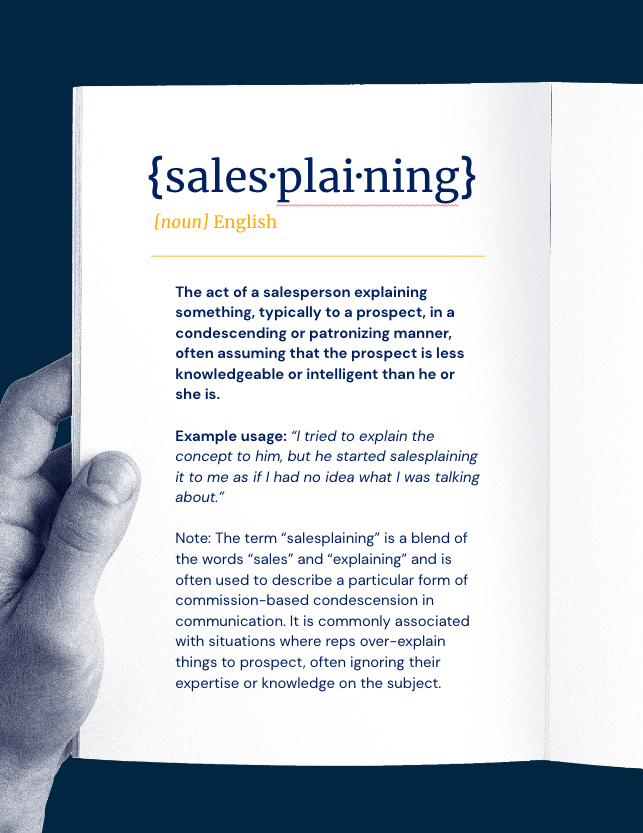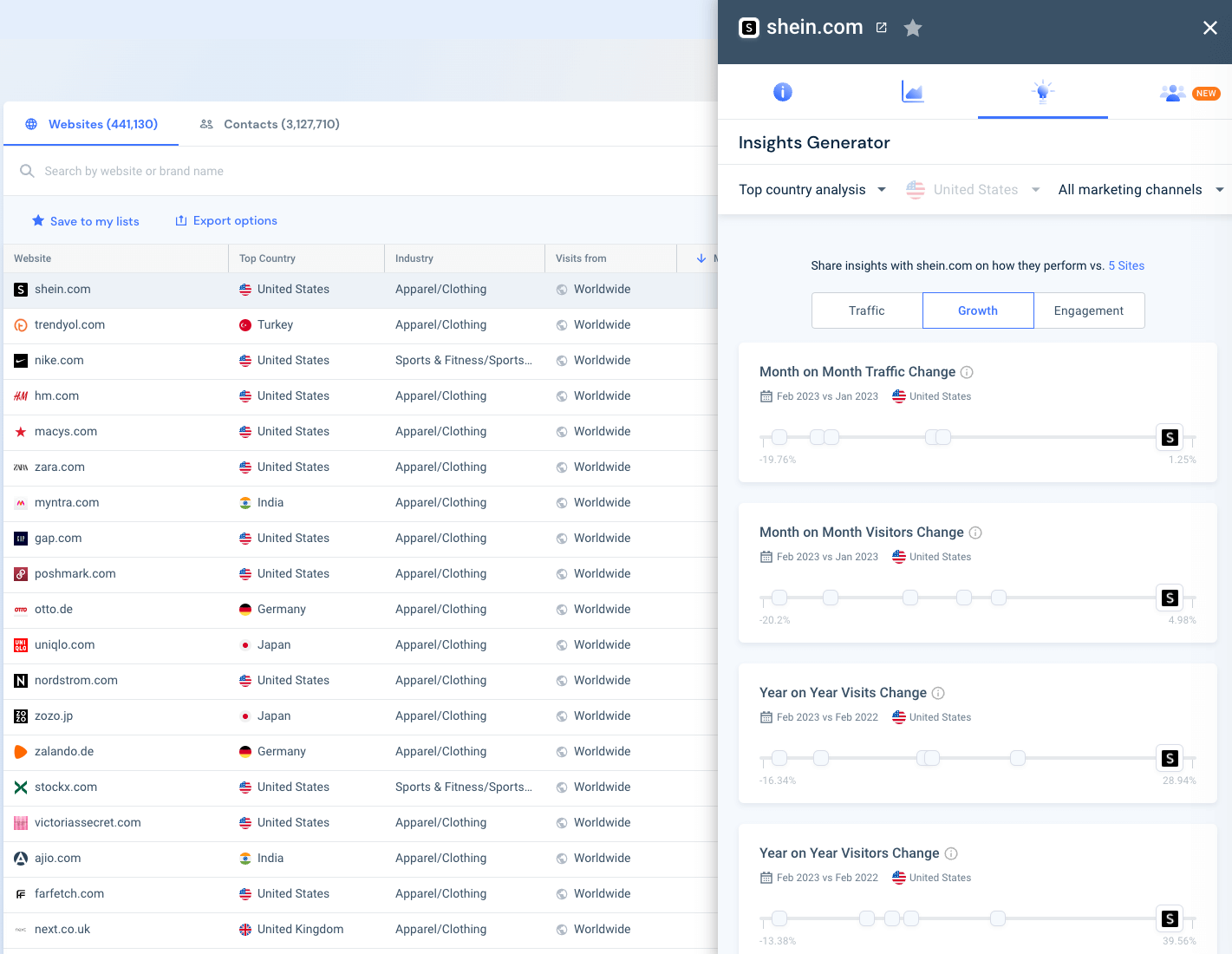The Do’s and (Definitely) Don’ts of Consultative Selling

It always used to be “if you can’t talk the talk, don’t walk the walk”, but these days it’s more like “if you don’t listen, you can’t position [your product as the stand-out solution for your prospect]”.
Okay, we tried.
While it might not be as catchy, we stand by the fact that listening is the oldest, yet most underrated, sales technique on the block.
Sales was having a moment with the introduction of email automation, generalistic sales email templates, and strict call scripts, rounded off nicely with some classic gift of the gab. This got boring real quick. Why? Because everyone was doing and saying the same thing.
The stereotype of a traditional salesperson (along with all those repetitive email templates and list of buzzwords to include) is – or should be – a distant memory. It’s a stereotype that has become problematic to the world of sales and its engagement with prospects.
No one wants to pick up a cold call, everyone’s inboxes are flooded with the same-old emails on a daily basis, and a lot of people feel they can’t trust anyone that has “sales” on their LinkedIn profile. With that salesperson stereotype of telling others what they want and why they should pay them for it right now, it’s easy to see why.
So, let’s talk about redefining that stereotype.
That’s why we’re all about value selling these days. Moving away from ‘salesperson who only cares about selling their product to hit their target so they can get into President’s Club or go on a good holiday in summer’ and into the realms of going above and beyond to help your prospective customer. That’s where you, as a salesperson, want to use your deep understanding of your prospects to build credibility and help them achieve their goals.
If you go beyond selling your own product, guiding your prospects in other areas of their business too, you’ll win more as a result.
Sounds good, doesn’t it? So here’s our guide on what-to-absolutely-not-do VS what-you-should-be-doing (hint: it’s all about nailing your consultative selling approach).
1) The salesperson monologue
❌ What you shouldn’t be doing:
When your prospect sees an unknown number calling or an unfamiliar name come through to their inbox, a strong feeling of dread can quickly kick in.
“Will this just be another salesperson talking 123mph about a product I’ve never heard of, quote stats that just aren’t relevant to me and my business, and not even give me a breath to explain what my business actually does?”
✅ What you should be doing:
In short: listen.
Asking the right questions and listening to what your prospect has to say is a whole lot better than a one-sided conversation. Not just for your prospect, for you too.
With the perfect combination of automation (like sales intelligence platforms) and conversation, you can fuel your consultative selling approach with all the industry, company and competitor analysis you need.
That’s the difference between irrelevant, surface level questions and questions that really peel back the layers of your prospect. With that you can find out what they are really about and work with that to move them down the sales funnel.
Researching your prospect ahead of the call is key, but let’s be real: most of us aren’t putting in the time we should. In as little as 10 minutes, Similarweb can give you a deep understanding of the challenges and opportunities – so you can ask the right questions and power up your conversation with valuable insights about the clients you’re speaking to.
2) The armchair critic
❌ What you shouldn’t be doing:
There’s nothing worse than someone telling you how to do your job, and it’s no exception when it comes to SDRs speaking to someone that’s been in the game a long time. You know, “this is what you want, this is why you should speak to me, this is the right way to do it, and this is why you need to buy the snake oil I’m selling”.
✅ What you should be doing:
Watch yourself, and remember to have some perspective.
Firstly, you need to know exactly who you are speaking to. Whether it’s all in the CRM already or requires a cheeky LinkedIn stalk, know your audience. Secondly, more often than not, the decision-makers you’ll be speaking to will be in more senior positions – learn from them, hear what they are saying.
You’ve got to earn the right to ask the more intrusive questions – and the more senior they are, the more impressive you’ll need to be. You need context to your contacts.
3) The (not-so-trusty) sales template
❌ What you shouldn’t be doing:
BRB while I copy and paste one of Neil Patel’s outreach email templates and fill in the gaps. Let’s ignore the times when I accidentally forget to edit the [insert random blog post here] or change the name I’m addressing it to.
☝️ That there, is a thing of your prospects’ nightmares when it comes to your sales activities.
It seems lazy, it seems impersonal, it seems like you just want to hit that quota and be done with it. As Black Eyed Peas famously said: “Where is the love?”.
✅ What you should be doing:
We totally get it. Templates do save time. However, the number of sales emails you send out is not the aim of the game. It’s the number of prospects that bite – and that’s exactly where you’re letting yourself down.
That all-important touch of personalization will set you apart from the rest, and capture your prospect’s attention and interest – because it shows you have put work into your outreach. And yes, this does need to go a lot further than their first name.
We’re talking data, we’re talking insights, we’re talking pain points – and we’re talking things that maybe they weren’t even aware of before you started speaking to them.
Enter: Similarweb Sales Intelligence with our trusty Insights Generator, ready to give you all the goods.
Take this as an example. With Similarweb, you can get a list of the top ecommerce companies in the world (or whatever industry or wherever you want). You can then dig into your chosen companies’ overviews, where you’ll find core digital metrics. These metrics are guaranteed to get your prospects listening, and your clients trusting your advice and consultation to boost their digital presence and performance, and rise above the competition.
Oh, and don’t forget about follow-up questions – make observations using your intel, and ask how they feel those occurred.
4) The “it’s a numbers game” pipeline
❌ What you shouldn’t be doing:
On top of using average-to-below-average templates to save time, there are a bunch of other ‘shortcuts’ we know you guys come up with. Because you’ve got that simple equation in your head: the more emails and calls you push out, the more signed contracts you’ll get back. You know, that whole ‘throwing at a wall and seeing what sticks’ vibe.
That’s how it works, right?
Wrong. So, so wrong.
✅ What you should be doing:
Quality > quantity. That should be your focus – trust us on that one.
No one wants to feel like ‘just a number’ or the same as everybody else. These days, your prospects will spot those red flags a mile off, and swiftly reject your advances or… ghost you. (Sound familiar?).
How’s all that going to leave your pipeline looking?
It’s all about the quality of your leads, making sure they are properly qualified to fit with your ideal customer profile (ICP) and are ready to buy. The others? You can archive and avoid wasting your time.
Generate leads ➡️ enrich your data ➡️ score those leads ➡️ qualify to find the right match.
(Ahem… you can actually get all that with Similarweb Sales Intelligence. Open our free trial in a new tab – because we know you’ve got 20+ open already).
5) The killing-multiple-birds-with-one-stone sales call
❌ What you shouldn’t be doing:
If your initial call is anything like that headline and hardly gives you (or your prospect) room to breathe, you’re saying too much. We’ve said you need to hold back on the salesperson monologue, but we also need to tell you: watch what you’re saying too.
It can be tempting to go from 0 – 100 in sales calls and communication to save yourself time, but that just ain’t gonna cut it anymore.
✅ What you should be doing:
Take a breath and take your time. Don’t rush the process, because the reality is that pitching is just the start. The majority of your time will be spent closing.
To get to the finish line, your prospect needs to trust you – and to earn that trust, your time should be spent:
- Listening to your prospect
- Asking the right questions
- Learning their needs
- Building your credibility as a guide by arriving with valuable data and insights (hello, Similarweb Sales Intelligence)
- Tailoring your offering to fit them
- Thinking about comms and execution at each step
Getting that initial interest to move forward is just the tip of the iceberg, and the rest of the sales process is a slow and patient process with stakeholders, not to mention legal and finance.
You want them to like you, trust you, and be invested in the process – don’t clutter a call with a combination of every stage of your sales process because it’s faster. Be mindful about where your prospect is in the journey, and ask the relevant questions.
It’s like sprinting to the finish line before the whistle has been blown – a waste of your energy, and ironically, the only real waste of time in this equation.
6) The bad sport salesperson
❌ What you shouldn’t be doing:
We’ve all heard of bad sportsmanship, but what are some examples of bad salesmanship?
For starters, we’ve got:
Getting angry and defensive when you’re told ‘no’
Refusing to let go of the fact a prospect ghosted you in 2019
Not being a team player and only thinking about that sweet, sweet commission
…to name just a few. None of them are looking too pretty, are they? And believe us when we say, those traits will have a nasty impact on your success rate too.
✅ What you should be doing:
The common thread out of all those traits is ego, and you should never get too big for your boots. Rejection happens and ghosting happens – but one thing that shouldn’t happen is letting those things get to you.
Never feel too hurt and rejected to follow-up or double (hey, even triple) message, or at least end it on good terms with a good old sales break-up message. You never know, they might see you in a new light when the timing is right.
Here are some stats and numbers that will ease the – temporary – heartbreak:
- The optimal number of follow-up emails to send is 2 to 3.
- 95% of all converted leads are reached on the sixth phone call attempt.
- 60% of customers say “no” four times, before saying “yes”.
It’s time to quit salesplaining
So, there we have it – the sales angel and sales devil on each of your shoulders. Disclaimer: the devil can’t win a deal anymore.
Yeah, we know which one you want to be.
With the art of value selling, you’ll be able to build credibility, trust and rapport with your prospect – and you’ll avoid a few (/a lot) of eye rolls you get from any cliché sales chat.
The best bit? It’s not just your image you’ll be improving (goodbye, seller stereotypes). Consider the positive impact on your win rate, retention rate, referrals, and namely, your customer experience.
How about that for a win, win, win, win, win, win, etc?
Nail your consultative selling with Similarweb
One way to become a trusty advisor for your prospects and clients in no time at all? Having Similarweb Sales Intelligence at your fingertips.
Find valuable data and insights about your prospects’ website performance and technologies, see what their competitors are up to, understand your target audience, market and industries at a deeper level, and win more deals as a result.
Find valuable data and insights for your next call with Similarweb Sales Intelligence. Try it for free today.
FAQs
What is consultative selling?
Consultative selling is an approach to sales where the salesperson acts as a consultant to the prospect, working to understand their needs and provide solutions that meet those needs. Rather than simply pushing products or services, consultative selling is about building relationships and providing value to the customer.
Why is consultative selling important?
Consultative selling can help build trust and credibility with prospects, leading to longer-lasting relationships and repeat business. By understanding the customer’s needs and providing tailored solutions, the salesperson can position themselves as a valuable resource rather than just another salesperson.
How can I improve my consultative selling skills?
Improving your consultative selling skills involves a combination of active listening, asking thoughtful questions, providing valuable insights and information, and building rapport with the customer. You can also consider taking training courses or working with a mentor to hone your skills and gain feedback on your approach.
Take your sales strategy to the next level
Try Similarweb Sales Intelligence today — free of charge







![How to Smash Your Next Sales Presentation [15 Tips and Tricks]](https://www.similarweb.com/blog/wp-content/uploads/2021/11/Tips-for-sales-presentations-1-768x456.png)

